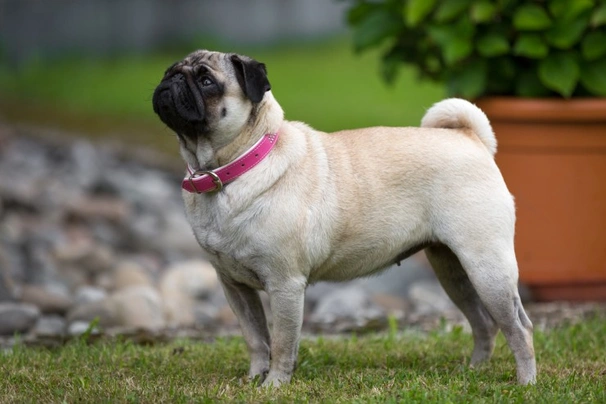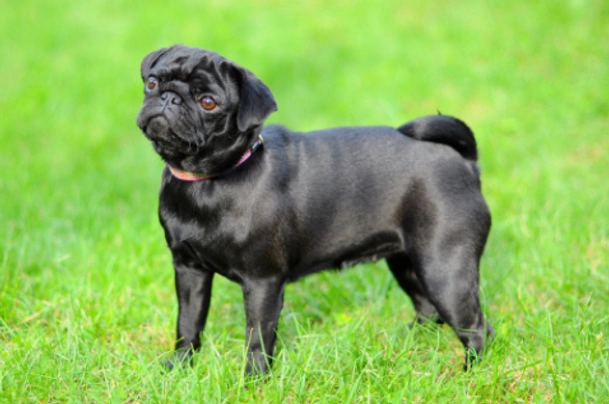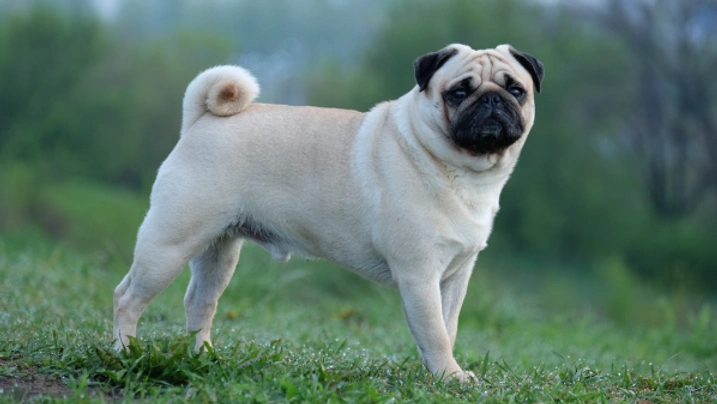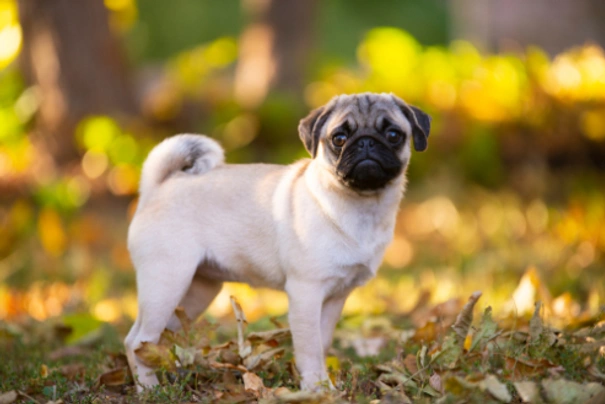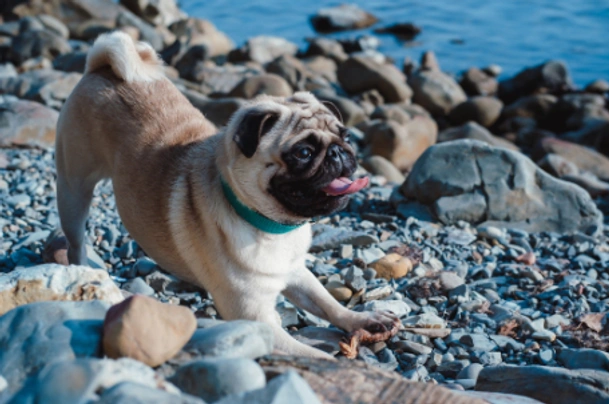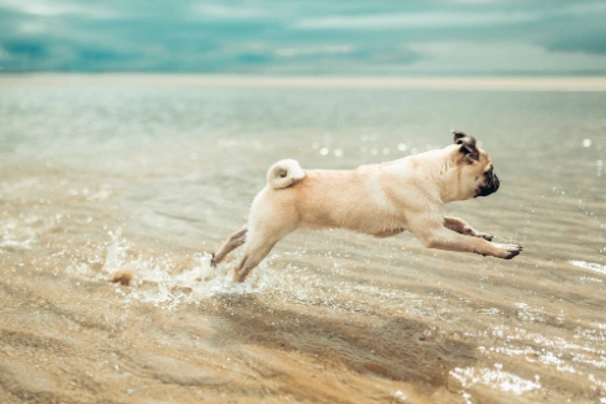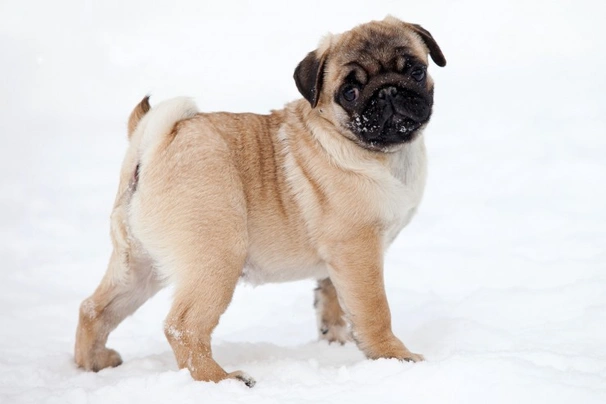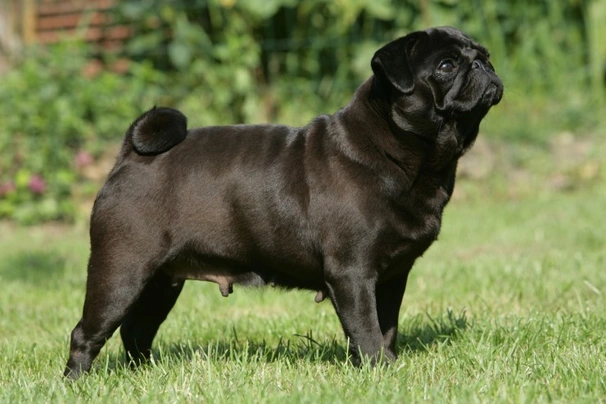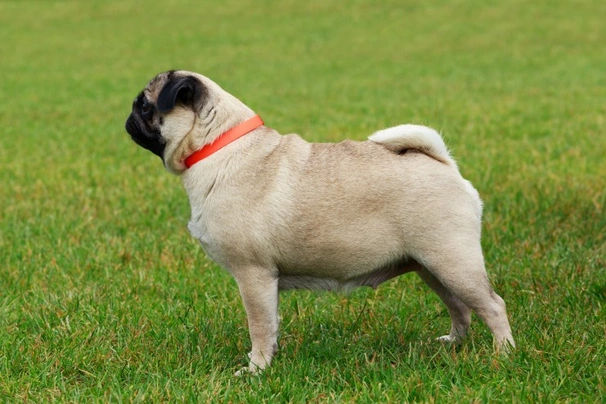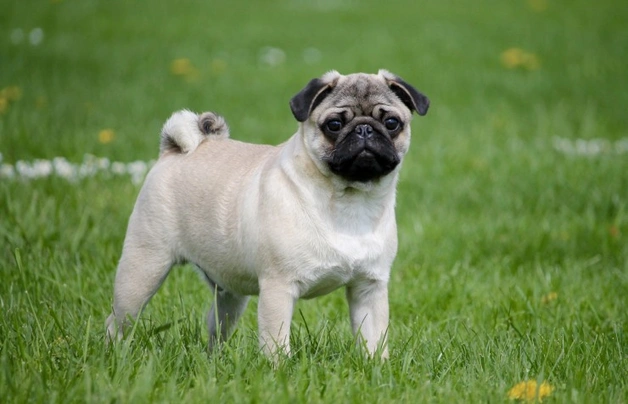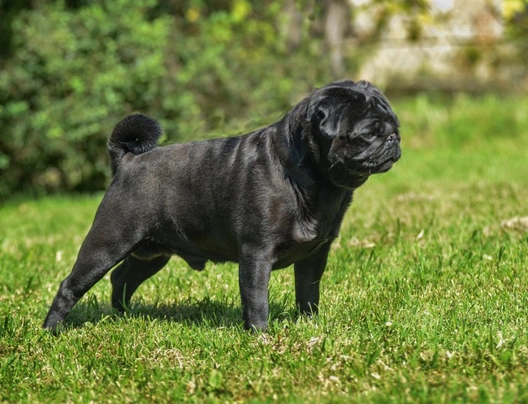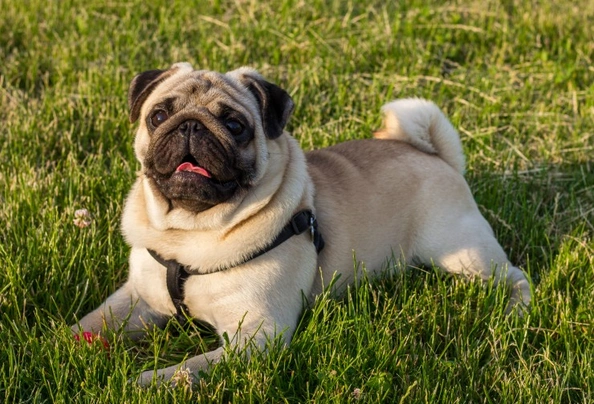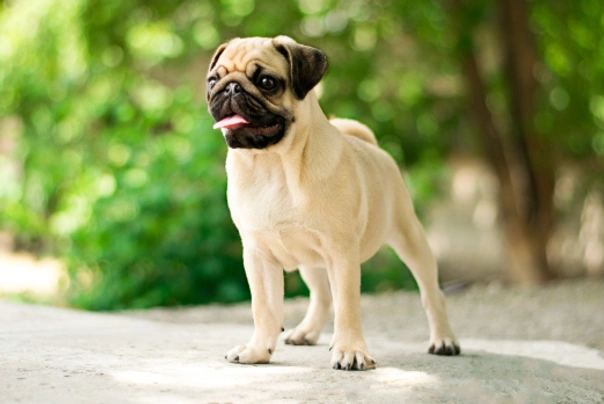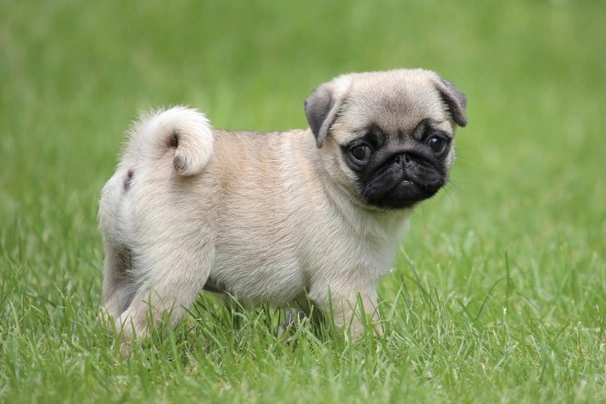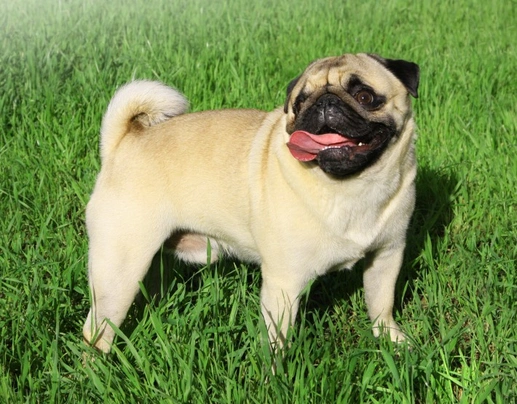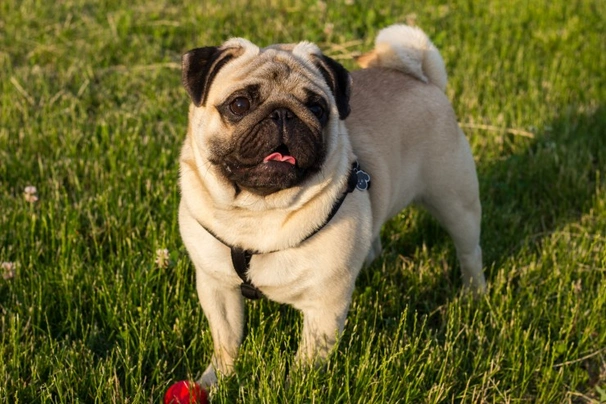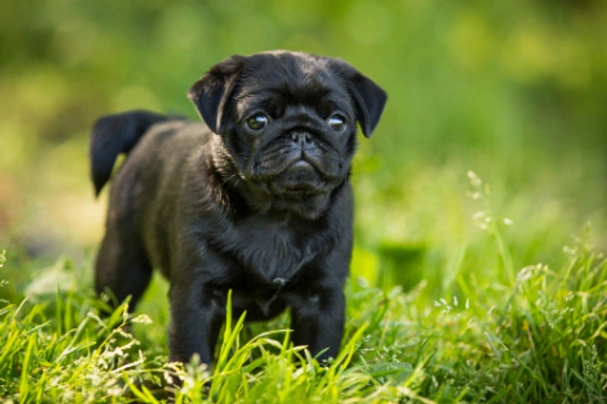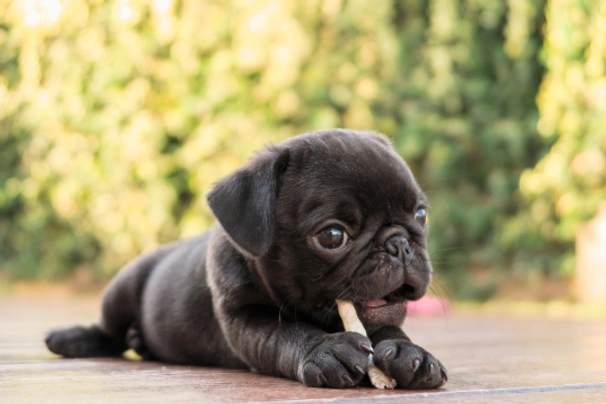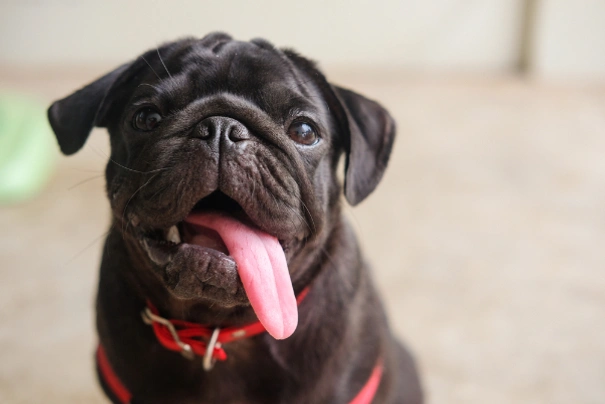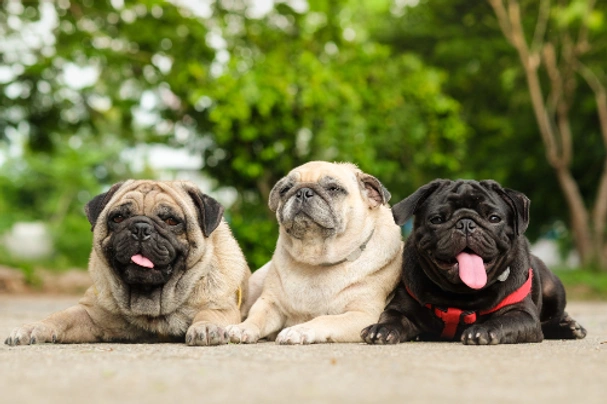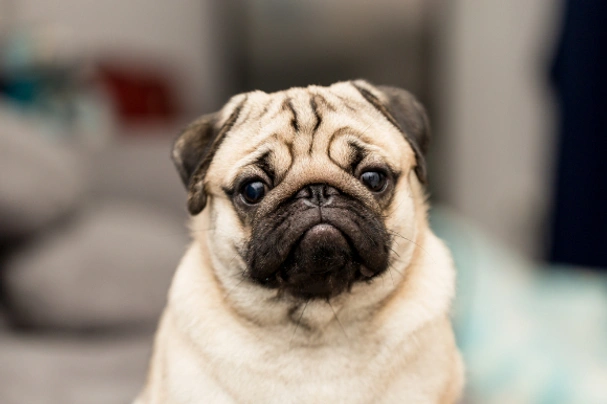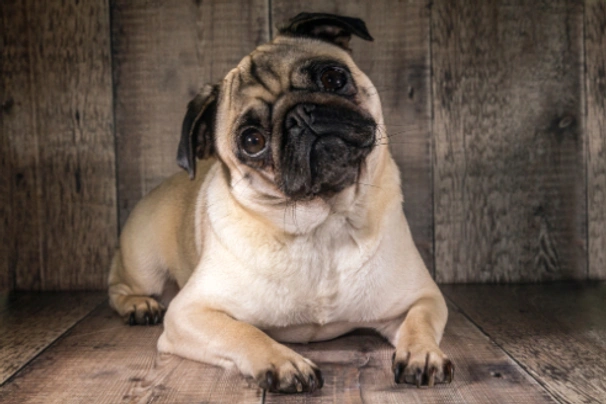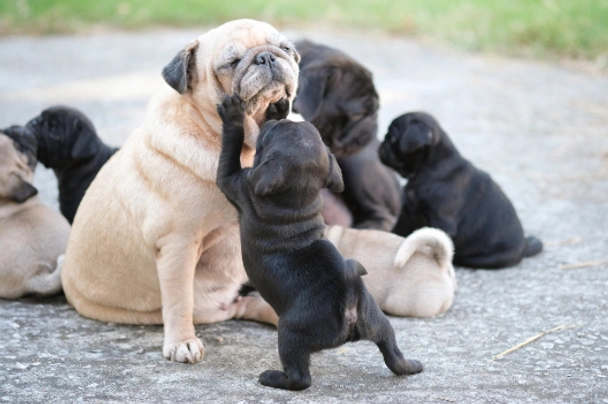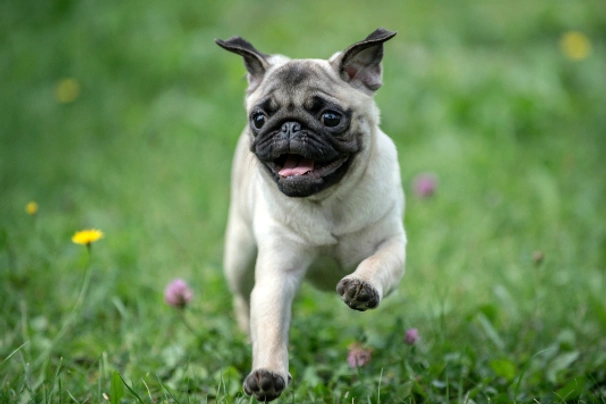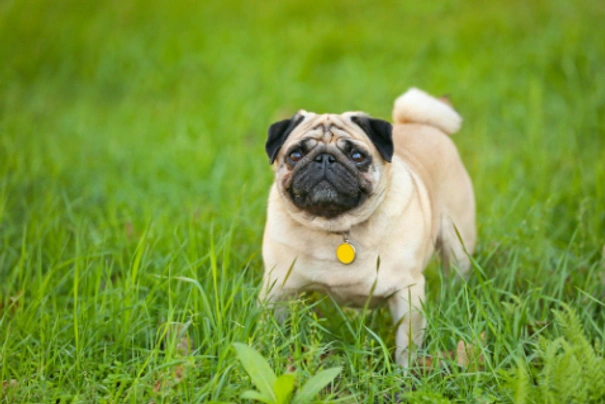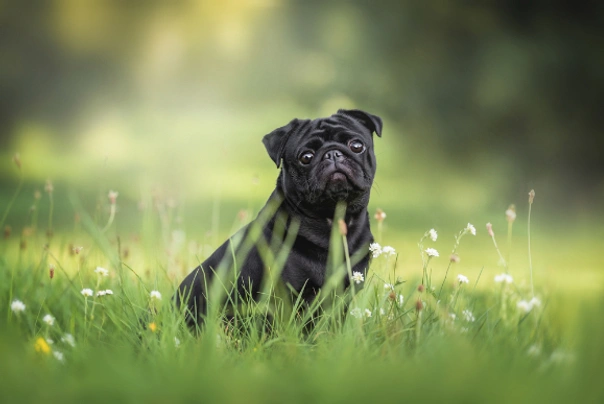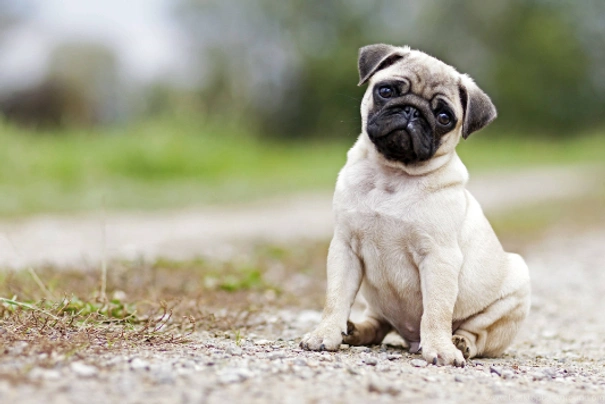Pug
Pros
Cons
Introduction of the Pug
The Pug remains one of the most popular breeds to own not only here in the UK but elsewhere in the world and for good reason. Pugs may be small in stature but they have big personalities and are extremely intelligent little dogs. They are confident by nature with an affectionate and mischievous side to their natures that endears them to just about everyone they meet. They adapt well to family life and other lifestyles which are just some of the reasons they have remained just as popular today as they were centuries ago. Pugs are incredibly people-oriented and hate it when left on their own for any length of time but once you've shared a home with a Pug there'll be no going back.
History of the Pug
Pugs have been around for a very long time with records of them dating back to 700 BC in Ancient China where they were bred and owned by Emperors. The common people were not allowed to own a Pug and if one of these treasured dogs was found in their possession the punishment was death. Pugs were so revered at the time they even lived in their own part of a royal palace and were attended on by their own servants too. Female Pugs were given the same status as an Emperor’s wife and guarded by soldiers only being fed the best of everything.
Although the exact origins of Pugs remain unknown they are considered one of the most ancient breeds on the planet. Originating in Ancient China where only Emperors could own a Pug these little dogs found their way over to Europe when China allowed Dutch explorers to trade in their lands. It is said that sailors smuggled these little dogs out of China and once back home they were an immediate hit with the nobility and upper classes due to their small size and sweet natures.
Pugs were first seen in England in the 17th Century with records of William III owning one. They became the "official dog" of Dutch royalty around the same time before gaining popularity in other European countries including Spain France and Italy. At the time Pugs were different to the dogs we see today because they had longer faces and legs. They remained popular throughout the 18th Century but they fell out of favour for a short time after that.
In 1860 a new type of Pug was imported from China and these dogs boasted shorter noses and shorter legs. Their "pug noses" were an immediate hit with Queen Victoria and very soon the breed was once again popular with many royals. It was Queen Victoria who banned people from cropping a Pug's ears because she deemed it cruel. During the 20th Century it was the Duke and Duchess of Windsor who once again bought the breed into the limelight taking their pets with them wherever they went.
The breed fell out of favour again for a short while during the 20th Century but today Pugs are among one of the most popular breeds on the planet which can be put down to the fact one of these adorable looking little dogs played the part of "Frank the Alien" in the Hollywood movie Men in Black.
Interesting facts about the breed
- Are Pugs a vulnerable breed? No they are one of the most popular in the UK and elsewhere in the world
- Pugs are one of the ancient breeds in the world
- In times long past Pugs were treated like royalty in their native China
- Pugs are a brachycephalic breed
- Prince William of Orange was saved by his Pug in the 16th Century when his dog barked alerting him that Spanish troops were about to ambush his camp and became the official breed of the House of Orange
- Napoleon's wife Josephine owned a Pug called Fortune
- Queen Victoria was a huge fan of the breed and it was through her efforts that the practice of cropping a Pug's ears was banned
- Groups of Pugs are referred to as "grumbles"
- Pugs should have two curls in their tails
- Pugs are susceptible to catching colds because of their short noses
Appearance of the Pug
Schofthoogte: Reuen 25,4 - 35,56 cm Teven 25,4 - 35,56 cm
Gemiddeld gewicht: Reuen 6,3 - 8,1 kg Teven 6,3 - 8,1 kg
Mopshonden zijn compacte robuuste en goed geproportioneerde, zo niet enigszins vierkant uitziende hondjes. Hun hoofd is echter vrij groot in verhouding tot hun lichaam en ze zijn rond met korte zwarte snotneuzen die vrij groot zijn in verhouding tot de grootte van hun hoofd. Hun belangrijkste fysieke kenmerken zijn hun expressieve grote donkere ogen en de schattige rimpels rond hun gezicht.
De oren van een mopshond zijn klein en voelen aan als fluweel. Er zijn twee soorten: het Knoopoor en het Rozenoor. Hun monden zijn heel lichtjes ondervoorbijtend, wat bijdraagt tot hun algemene aantrekkingskracht. Hun sterke en dikke nekken zijn licht gebogen, wat de mopshond een trotse uitstraling geeft.
Hun voorvoeten zijn robuust, goed gespierd en sterk met mooi aflopende schouders. Het lichaam van een Mopshond ziet er zeer bobbelig uit en is breed in de borst met goed gewelfde ribben en ze hebben een vlakke bovenlijn. Hun achterhand is sterk en goed gespierd en Mopshonden hebben sterke en goed ontwikkelde achterbenen. De voeten zijn netjes en verzorgd met goed gedefinieerde tenen en zwarte nagels. De staart van een Mopshond is strak gekruld en hoog aangezet en dubbele krullen worden gunstig beoordeeld als rasstandaard. Hun lichaam moet goed gedefinieerde harde spieren hebben, wat niet verward moet worden met overgewicht.
Qua vacht heeft een Mopshond een korte glanzende gladde en fijne vacht met een goed gedefinieerde zwarte lijn die helemaal over hun rug loopt. Ze hebben ook een mooi donker masker en hun aftekeningen in hun vacht zijn goed gedefinieerd. Deze markeringen moeten altijd zo donker mogelijk zijn, inclusief eventuele moedervlekken die een hond heeft op zijn wangen, diamanten op zijn voorhoofd of duimafdrukken op zijn lichaam.
Aanvaardbare vachtkleuren voor Mopshonden zijn de volgende:
Zilver
Abrikoos
Fawn
Zwart
De kleuren zijn duidelijk gedefinieerd, zodat contrasterende kleuren op het gezicht van een hond en andere delen van het lichaam duidelijk zijn. Hun aftekeningen moeten mooi gedefinieerd zijn en snuiten oren evenals de moedervlekken op de wangen van een hond en de ruit- of duimmarkering op hun voorhoofd en sporen moeten zo zwart mogelijk zijn.
Gangwerk/beweging
Mopshonden zijn compacte, sterke honden en als ze bewegen is dat doelgericht, met een echte "actie" van voren en van opzij gezien. Hun voorbenen bewegen sterk en hun achterbenen bewegen vrij met de voeten altijd naar voren gericht. Mopshonden vertonen een lichte rol in hun achterhand die typisch is voor het ras, maar dit mag nooit worden overdreven.
Fouten
Elke overdrijving in de bouw en bouw van een Mopshond wordt afgekeurd en door de Kennel Club beschouwd als een fout in het ras.
Het is ook belangrijk dat mannelijke Mopshonden twee testikels hebben die volledig in hun scrotum zijn ingedaald.
Temperament of the Pug
Pugs are renowned for their kind sweet natures which is why they have remained such popular companions throughout the centuries. Some people say that sharing a home with a Pug is more like living with a small child than a dog which is especially true when it comes to their need for attention. Pugs are ultra-sociable and they thrive on being around people. They do not do well when left on their own for longer periods of time. If they are left to their own devices for hours on end Pugs can become a little destructive around the home through sheer boredom and because they develop separation anxiety.
Being highly intelligent Pugs also need to quite a bit of training and it's important to handle them gently yet firmly because they can be mischievous and naughty at times. It would be fair to say that Pugs need more time spent on their training than a lot of other breeds just for this reason. It's also worth bearing in mind that these little dogs remain extremely puppy-like throughout their lives which is why they are such great fun to have around.
The breed is known to be extremely friendly even when they are around people they don't know. Another nice trait is that although they are very affectionate Pugs are not clingy although they do like to be with the people they love but when they have been given enough attention a Pug will quite happily go off and do their own thing. Pugs need to know their place in the "pack" and who is the alpha dog or they might show a more dominant side to their characters which is something to be avoided at all costs in any breed because it can make life for both a dog and their owner a lot less enjoyable.
A well socialised and trained Pug is a joy to have around and they thoroughly enjoy being the centre of attention loving nothing more than to play the clown. There is a downside to sharing a home with a Pug puppy though and this is that they can be notoriously difficult to house train.
Are they a good choice for first time owners?
Pugs are a great choice for first time dog owners providing they have lots of time to spend with their canine companions. Pugs form strong ties with their owners and never like to be left on their own for too long. It can also take time and patience to house train a Pug puppy with some dogs taking months to learn where to do their “business”.
What about prey drive?
Pugs are feisty by nature and although they will give chase to the cat from next door they do not have high prey drives preferring to get on with everyone because they are so social by nature.
What about playfulness?
Pugs are known to be real clowns and love entertaining their owners. Being the centre of attention makes these little dogs very happy. They adore playing interactive games and will spend as much time clowning around with their families as they can. They are known to be quite child-like and remain so well into their mature years.
What about adaptability?
Pugs are highly adaptable and do just as well living in an apartment as they would when living in a house providing they are given plenty of mental stimulation and daily exercise. Pugs need a lot of mental stimulation and they enjoy playing interactive games indoors which means investing in some good quality robust toys.
What about separation anxiety?
Pugs form strong bonds with their families. They like being involved in things that go on in the home although they are not known to be clingy. With this said it would be very unkind to leave a Pug on their own for any length of time because they are so people-oriented and if they do find themselves alone it can lead to a Pug suffering from separation anxiety which often sees a dog developing unwanted destructive behaviours. When this happens a dog might start barking excessively too which is their way of relieving any stress they are feeling.
What about excessive barking?
Pugs have funny voices and are not known to be overly vocal although some of them are barkers and others are much quieter. They are intelligent and can be taught not to bark for no reason but this needs to be done without being too hard on a young Pug which could end up with them being timid and shy. Most Pugs develop barking issues when they are unhappy at being left on their own or when they have not been correctly socialised at a young age. A Pug that's not been socialised is more likely to get over excited when they meet anyone for the first time or when they find themselves in unfamiliar situations and environments. This typically ends up with them expressing their feelings through excessive barking.
Do Pugs like water?
Pugs do like swimming and will instinctively take to water when the weather is warm. However a dog must never be thrown in because it would just scare them. It would also be a mistake to put a puppy or a young pup in water unless it is bath time that is. It's best to wait until your Pug is that much older and to avoid letting them swim in pools because of the chemicals used in them. Because of their short noses care should be taken when a Pug goes swimming because water can easily get up their noses which can cause them all sorts of breathing problems.
Intelligence / Trainability of the Pug
Pugs are intelligent little dogs however they do boast a bit of a stubborn streak in them which means it takes a firm yet gentle hand when it comes to training them. It is also essential for owners to be consistent and always fair because Pugs are quite sensitive by nature even if they are stubborn at times. Rules and boundaries must be established early when living with a Pug and they need to be taught their place in the "pack" and who is alpha dog in a household to prevent them from developing any unruly dominant behaviours that would prove hard to correct.
Pugs respond well to positive reinforcement and will not do well if they are handled roughly. They do not answer well to harsh training methods either and the same can be said of how they are told off. If this is done too harshly it could have an adverse effect on a dog rather than a positive outcome. Pugs are renowned for testing boundaries and limits which means being firm and consistent throughout a dog’s life remembering that it’s in a Pug's nature to see how much they can get away with before being told off.
Children and other
Pugs are renowned for their genuine love of children. They are robust little dogs that enjoy being around kids even when playtime gets a bit on the rough side. However as with any other breed it's always best to supervise children when they are around dogs to make sure things stay calm and that things don't get too boisterous which could end up with a child or a Pug being frightened or hurt.
Pugs are also known to be good when they are around other pets and animals which includes cats. They rarely show any sort of aggressive behaviour towards other dogs or pets which is another reason why they are so popular the world over as family pets and companions. However as with any other breed Pug puppies need to be well socialised from a young age so they grow up to be confident outgoing and well-rounded mature dogs that take everything in their stride.
Health of the Pug
The average life expectancy of a Pug is between 12 - 14 years when properly cared for and fed an appropriate good quality diet to suit their ages.
Because Pugs have a relatively small gene pool the breed is known to suffer from quite a few hereditary health issues some of which are quite serious. These include the following:
Eye Disorders
- Cataracts
- Distichiasis
- Entropion(Eyelids Folding Inwards)
- Exporsure Keratopahty Syndrome
- Keratoconjunctivitis sicca (Dry eye)
- Progressive Retinal Atrophy (PRA)
- Pannus
- Pigmentary Keratitis
- Corneal ulcer
Muzzle Problems
- Elongated Soft Palate (ES)
- Stenotic Nares
Intestinal Issues
- Intussusception - male dogs under the age of 18 months
Leg Problems
Spine Issues
Neurological Health Issues
Because Pugs have remained so popular and therefore in high demand the breed's health is of the utmost importance. A responsible well established breeder would do their utmost to ensure that all their breeding dogs are sound and healthy so that any offspring they produce are less likely of inheriting hereditary or congenital disorders the breed is known to suffer from.
What about obesity problems?
Pugs are known to like their food and in some dogs this is a little too much. Overfeeding a Pug can lead to obesity which could shorten their lives by several years. An overweight Pug would be less playful they would be more reluctant to go out for walks which in short means the quality of their lives can also be negatively impacted too. A Pug should always be fed a good quality balanced diet that meets their nutritional needs at the different stages of their lives and treats should be kept to a minimum and only given as the occasional food reward.
What about allergies?
Some Pugs suffer from allergies and finding the cause can often prove challenging. A good way of helping establish just what might be triggering a dog's complaint is to keep a journal noting down what your Pug eats. In the spring when plants and flowers are starting to bloom it’s important to make a note of when your dog shows any signs of experiencing an allergic reaction. The more information you can give the vet the easier it would be for them to establish just what is triggering an allergy in your Pug but this could still take quite a bit of time trial and a lot of effort.
Recognising health issues in Pugs
Because Pugs are prone to suffering from certain eye issues it's essential for owners to regularly check their pet's eyes and to treat a problem early. A Pug's eyes should be gently wiped clean if there is a slight discharge using a soft damp cloth. If there is a lot of discharge and a Pug's eyes look irritated and inflamed it is time for a trip to the vet. The earlier a diagnosis and treatment can be set in place the better.
Any time a Pug looks off colour and they are not acting like their normal selves the earlier they are examined by a vet the better because most health concerns when caught in their early stages are that much easier to treat and the outcome is therefore a lot more positive for a dog.
Participating in Pug health schemes
Pug owners can take part in the Hemivertebrae Scheme which all responsible and well-established breeders have joined to ensure their Pug puppies are less likely to develop this debilitating disease. By having stud dogs both male and female X-rayed before they are used for breeding purposes reduces the chances of parent dogs passing the condition on to their offspring. The scheme is one that is recognised by the Kennel Club.
It is worth noting that Pug Breed Clubs in the UK recommend that owners and breeders always ask their vet's advice prior to having Pug's undergo X-ray tests.
Breeding restrictions
A dam must only whelp 4 litters and as such no puppies can be registered with the Kennel Club if they are from any further litters a dam produces. A dam that produces 2 litters in any 12-month period would be frowned upon by the Kennel Club because the recommended time between litters should be 12 months. Any breeder who produces more than 4 litters a year must be licensed by their local authorities.
A female Pug's age also plays an important role as to whether she should be used for breeding purposes. Dogs over the age of 8 or under 12 months old should not be used for breeding purposes. Other restrictions apply which can be found on the Kennel Club website.
What about Breed Specific Restrictions?
Merle Pugs are no longer recognised by the Kennel Club. As such they cannot be registered whether a puppy was born in the UK or abroad. The reason being the merle gene carries a greater risk of Pugs suffering from sight issues and impaired hearing.
Caring for the Pug
Looked after correctly Pugs are pretty low-maintenance little dogs. As with any other breed they need to be groomed on a regular basis to make sure their coats and skin are kept in tip-top condition. It's important to keep the wrinkles around the faces nice and clean to avoid any sores developing. They also need to be given regular daily exercise so they remain fit and healthy. On top of this Pugs need to be fed a good quality well-balanced diet that meets their nutritional needs throughout their lives.
Caring for a Pug puppy
Getting a Pug puppy into a routine from the word go helps them through what can be a stressful and anxious time. The routine means feeding a puppy at the same time of the day and establishing a daily grooming schedule which helps reinforce the bond between owner and puppy.
Puppies should have already been wormed by the breeder prior to them being rehomed and their mother should have also been regularly wormed prior to her giving birth so that she does not pass on any intestinal worms to her offspring. The documentation a breeder provides for a puppy must have all the details of their worming date and the product used as well as the information relating to their microchip. It is essential for puppies to be wormed again keeping to a schedule which is as follows:
- Puppies should be wormed at 6 months old
- They need to be wormed again when they are 8 months old
- Puppies should be wormed when they are 10 months old
- They need to be wormed when they are 12 months old
Pug puppies can be quite boisterous but care should always be taken making sure that playtime never gets too rough. It's also important for their new environment to be safe for them to roam around in which includes both indoors and outside in the garden. Puppy proofing a home and a garden can take a bit of thought and time which is why it should be done well before a puppy arrives home.
Puppies also need to have a quiet corner where they can relax and sleep because they need to take lots of naps throughout the day. Puppies can sleep for anything up to 21 hours a day. Their bed or crate should be away from too much traffic but somewhere that is not too out of the way so you can keep an eye and ear on them. It's also important for puppies not to feel they are on their own and although they might not be able to see people they should be able to hear there is someone around during the day when they are napping.
Items you'll need for a new puppy
Getting the home ready for when a Pug puppy arrives means sourcing some good quality items for them. It's a good idea to restrict the amount of space a small puppy's can run around in so they don't get under anyone's feet which could at best end up scaring them or at worst a puppy might get injured should someone accidentally step on them. The items you'll need to invest in are as follows:
- A good quality playpen that's large enough for a Pug puppy to express themselves in without it being too big so they feel lost in it
- Lots of well-made toys and this should include good quality chews for puppy to gnaw on bearing in mind that a puppy will start teething anything from when they are 3 to 8 months of age with Pug puppies teething a little sooner than many other breeds
- Good quality feed and water bowls preferably ceramic ones that are not too deep because Pugs have trouble reaching into deeper bowls because of their short noses and flatter faces
- A rubber mat for puppy to stand on when they are being groomed which is best done by placing them on a table making sure they don't fall off
- A grooming glove
- A slicker brush or soft bristle brush
- Dog specific toothpaste and a toothbrush
- Scissors with rounded ends
- Dog shampoo and conditioner which must be formulated for use on dogs
- A well-made dog collar and harness bearing in mind that it is better to walk a Pug in a harness rather than a collar because it puts no pressure on a young dog's sensitive neck
- A good quality dog lead
- A well-made dog bed that's not too small or too big
- Baby blankets to put in your Pug's crate and their beds for when they want to nap or go to sleep
A lot of Pugs don't like having their paws touched so it is very important to teach a puppy that this is nothing to be afraid of. Playing with their paws ears and touching their tails and nails helps get a Pug puppy used to things so that when nails need trimming it never becomes a dreaded task because your dog gets so stressed out.
It's also a good idea to get a puppy used to having their teeth brushed which needs to be done firmly yet very gently to begin with. They will still have their puppy teeth but getting them used to the routine will make things a lot easier when they grow their adult teeth which would need brushing every day to prevent dental issues from flaring up.
A lot of Pug puppies find it hard to settle at night when they first arrive in their new homes and the best way to get them to go to sleep is to make sure they are extra tired before they are put to bed. If they still won't settle it is best to leave them alone rather than go to them every time they whimper unless of course you think they sound as if they have got themselves into trouble. Settling a puppy into their new environment can be a little stressful but by setting up a routine can help them through the process.
Puppies should only be gently exercised because their joints and bones are still developing. They should never be given too much strenuous exercise which could result in them developing serious health issues later in life. Pug puppies like all puppies have bursts of energy in between lots of sleeping which puppies need to recuperate and grow. A puppy will sleep a lot more than a mature adult dog and can easily snooze for anything up to 21 hours a day.
Pug puppies are full of energy and when they play they play hard before collapsing and going to sleep again. They need to be fed a high quality nutritious diet that meets all their needs so they have the energy to play and enough left over to promote good growth. Puppies need to be fed several times a day which is typically 4 times in a 24-hour period. When they reach 4 months they can be fed 3 meals a day and this can continue right up to when they are 6 months of age. After that they can be fed twice a day for the remainder of their lives unless a vet advises otherwise.
It is essential to feed a puppy at the same times every day and to make sure their meal times are evenly spread out so that they don't develop hypoglycemia a condition where a puppy's blood sugar levels drop rapidly which can make a puppy very ill.
Keeping the noise down
Like all puppies Pugs are not fond of too much noise more especially when they first arrive in a new environment. It is important not to have the TV on too loud and not to play music too loudly either because a young puppy would find this overwhelming and it would stress them out.
Keeping appointments with the vet
One of the things a new dog owner should do is find out where their local veterinary surgery is and to introduce themselves so that if a problem arises with a puppy they can be taken to the surgery as soon as possible so they be examined. It is also crucial to keep veterinary appointments so a dog’s remaining vaccinations can be done and so that a puppy can be given a health check-up to make sure no health issues are flaring up.
What about older Pugs when they reach their senior years?
Pugs enjoy long life spans more especially if they have been well cared for with some dogs even living well into their late teens. As they reach their golden years a Pug's coat will start to have grey hairs running through it more especially around their faces and muzzles. Their coats can become thinner too and many older Pugs develop problems with their teeth and may even have lost some of them.
Older Pugs get stiffer on their legs and more especially on their back ones which is often a lot more evident first thing in the morning after they have been asleep all night. With this said older Pugs need more in the way of special care and attention. Their nails might need trimming more often because they are less active. Their hearing and their vision might not be as good as it once was which needs to be taken into account when living with an older Pug and their appetite might change too. Very often female Pugs put on weight in their senior years whereas their male counterparts drop weight.
The other thing to bear in mind is that older Pugs need a lot more sleep than younger dogs and their walks should be shorter too. Older dogs in general settle right down they are quieter although they are often less tolerant and as patient as they once were especially when they are around younger dogs. Some older Pugs can become a little more clingy around their owners too.
Grooming of the Pug
If there is one thing that Pugs enjoy it's being groomed because they love the one to one attention it involves. Being heavy shedders Pugs need to be brushed every day and it not only strengths a bond between owner and dog but it keeps their coat and skin in tip top condition too.
If you are about to get a Pug puppy it's important to start grooming them as soon as possible so they get used to the brush and all the other tools you would use to keep their coats looking good. You should also teach a puppy to have their nails touched which means that when and if they do need trimming you would be able to trim their nails without any drama or stress.
One thing that's worth noting is that fawn coloured Pugs have double coats but a dog with a black coat only has a single coat with the other difference being their hair is a little finer too. As with all other breeds Pugs shed more during the Spring and then again in the Autumn which is when more frequent brushing helps keep shed hair under control. Females also tend to shed more when they about to come into season which is also worth making a note of if you share your home with an unneutered female Pug. It is also a good idea to groom Pugs out of doors when they moult the most to prevent too much hair being left around the home.
When it comes to bathing a Pug this might need to be done on the odd occasion and ideally it should be when the weather is warmer so that a dog does not catch a chill. Pugs in general enjoy being bathed but hate it when they get their feet wet when out on a walk. You also need to make sure a Pug is thoroughly dried after having been given a bath paying special attention to the wrinkles around their faces. If any moisture is left in the folds it provides the perfect environment for bacteria to take hold which could lead to painful sores and runs the risk of an infection flaring up.
Ideal grooming routine
- Using a soft bristle brush or a hand glove brush your Pug's coat all over being careful and brushing them gently
- Using a soft damp cloth clean the wrinkles on the muzzle to remove debris and dirt that may have collected in the folds
- Using a soft cotton pad gently wipe your dog's ears all the while ensuring that you do not go too deeply into their ears
- Using guillotine nail clippers carefully trim your dog's nails when necessary
- Teeth need brushing daily using a dog-specific toothpaste
Exercise of the Pug
As previously mentioned Pug puppies should not be given too much exercise because it could have serious consequences on their well-being. Puppies are still growing and developing and as such only need to be given a little exercise to avoid having too much pressure put on their joints and backs. Pug puppies should not be allowed to run up and down stairs or jump up on furniture. They should always be lifted into a car too. Being allowed to run around and play in a garden is all that a puppy would really need in the early stages of their lives.
Mature dogs don't need a lot of exercise but Pugs need to be taken out for a brisk walk at least twice a day for 20 or so minutes each time. With this said if you have a secure garden there's nothing these little dogs enjoy more than spending as much time as they can out in it when you are at home and the weather is fine.
Care should be taken during the hotter weather because a Pug can easily get overheated not just when they are out on a walk but also if they lie in the sun for too long. During the summer it's best to take a Pug out for a walk early in the morning and then later in the evening when the sun is lower in the sky and the temperature has dropped to reduce the risk of them overheating.
A lot of Pugs don't particularly like going out when it's raining or cold outside and will refuse to take a step outdoors when the weather is bad which means you might have to gently coax them out to do their "business" when they need to. It's also important to invest in a nice warm coat for a Pug because they are not particularly fond of the cold either. If it is very wet and windy it's best to just take them out for a really short walk because weather conditions like this can seriously hurt a Pug's eyes. It's also important to keep an eye on their breathing when they are out on a walk to make sure they are not straining to catch their breath which could lead to them overheating.
However it's important for Pugs to be given enough exercise otherwise they will happily turn into couch potatoes which means they would end up putting on too much weight a problem that Pugs are prone to suffer from and carrying too much weight can seriously affect a dog’s health and wellbeing.
Feeding of the Pug
If you have just got a Pug puppy from a breeder they would have provided you with feeding instructions so they are fed the same amount of food at the same time of the day which helps avoid any digestive upsets. The breeder would also recommend a puppy be fed the same type of food to begin with for the same reason.
Puppies need to be fed more frequently than adult dogs and ideally this needs to be either 3 or 4 times a day. You can change a puppy's diet gradually over a period of a few weeks but you should do this very carefully always making sure they don't suffer any tummy upset in the process. Once a Pug is around 4 months old you can cut their meal times down to 3 a day remembering to give the same amount of food a day only split into three instead of four. At 6 months puppies can safely be fed twice a day.
Older Pugs should be fed a good quality well-balanced diet to suit their ages making sure it contains the correct levels of nutrients to meet a dog's needs. Some Pugs are fed three times a day throughout their entire lives but it is more usual to feed two meals a day once in the morning and then again in the evening.
Pugs are not generally fussy eaters and in fact quite the opposite is true because some dogs tend to like their food a little too much which means keeping an eye on a dog's weight and to always make sure they are getting enough exercise to burn off any excess calories. Obesity in Pugs is a real problem and could end up not only shortening their lives considerably but it would make moving around a lot harder so that going out for a walk is quite painful for a dog to do. Ideally an adult Pug should be fed a smaller meal in the morning and then a larger meal in the afternoon or early evening.
Feeding guide for a Pug puppy
As previously mentioned well established reputable breeders always give new owners a sheet showing what they have been feeding their puppies and the frequency of their meal times and it is important to keep to this to avoid any digestive problems. Changing a puppy's diet should only be done gradually over a period of 4 weeks and if they do develop a tummy upset to go back to their original diet before asking the advice of a vet or the breeder.
As a rough guide a Pug puppy should be fed the following amounts every day to promote good growth and development:
- 2 months old - anything from 105 g to 149 g depending on size and build
- 3 months old - anything from 121 g to 175 g depending on size and build
- 4 months old - anything from 127 g to 185 g depending on size and build
- 5 months old - anything from 128 g to 189 g depending on size and build
- 6 months old - anything from 127 g to 188 g depending on size and build
- 7 months old - anything from 115 g to 170 g depending on size and build
- 8 months old - anything from 103 g to 152 g depending on size and build
- 9 months old - anything from 92 g to 136 g depending on size and build
Feeding guide for an adult Pug
As a rough guide an adult Pug should be fed the following amounts every day to ensure they remain fit and healthy:
- Dogs weighing 6 kg can be fed 93g to 108g depending on activity
- Dogs weighing 7 kg can be fed 105g to 121g depending on activity
- Dogs weighing 8 kg can be fed 116g to 134g depending on activity
- Dogs weighing 9 kg can be fed 126g to 146g depending on activity
- Dogs weighing 10 kg can be fed 137g to 158g depending on activity
Pug price
If you are looking to buy a Pug you would need to pay anything from £500 to £1500 for a well-bred pedigree puppy. The cost of insuring a male 3-year old Pug if you live in the north of England would be £22.62 a month for basic cover but the premium rises to £45.08 a month for a lifetime policy (quote as of August 2017). An insurance company factors in quite a few things when calculating a pet's premium and this includes where you live in the UK and a dog's age and their breed.
When it comes to food costs you would need to buy the best quality food whether wet or dry for your dog throughout their lives and it must be one that suits the different stages of their lives. This would set you back between £30-£40 per month. On top of this you would need to factor in veterinary costs if you want to share your home with a Pug and this includes their initial vaccinations the cost of neutering or spaying your dog when the time is right and then their annual health check visits all of which can quickly add up to over a £800 a year.
As a rough guide the average cost to keep and care for a Pug would be between £60 and £80 a month depending on the level of pet insurance you opt to get for your dog but this does not include the initial cost of buying a well-bred pedigree Pug puppy.
Buying advice
When visiting and buying any puppy or dog there are many important things to consider and questions to ask of the breeder/seller. You can read our generic puppy/dog advice here which includes making sure you see the puppy with its mother and to verify that the dog has been microchipped.
When buying a Pug the size of a dog as stated by the Kennel Club Breed Standard is a guide only and is given as being the ideal for the breed. As such a Chihuahua could be smaller or larger and may weigh slightly more or less than the given size in their breed standard.
With Pugs there is specific advice questions and protocols to follow when buying a puppy which are as follows:
- Many well-established Pug breed clubs warn potential buyers of scams that exist and that many adverts show images of beautiful Pug puppies for sale. However sellers ask for money up front before they agree to delivering a puppy to a new home. Potential buyers should never buy a Pug puppy unseen and should never pay a deposit before collecting a puppy from a seller
- Pugs are among the most popular breeds in the UK and therefore puppies can command a lot of money. As such there are many people/amateur breeders who breed Pugs far too often so they can make a quick profit without caring for the welfare of the puppies their dam or the breed in general. As such anyone wishing to buy a Pug should think very carefully about who they purchase their puppy from and should always ask to see the relevant paperwork pertaining to a Pug's lineage their vaccinations and their microchipping
- Due to the high prices commanded for Pugs many pug puppies are imported from ireland and the EU purely to sold on for profit and not bred for the health and welfare of the dogs. It is important to make sure that any puppy you are looking at buying is NOT imported and has actually been bred in the UK. A few signs that they have been imported are that the puppies for sale are over 15 weeks of age the puppies mother is not available to be seen the puppy comes with a passport. So make sure you check for these signs and also check the puppies microchip and vaccination paperwork to make sure this has all been done in the UK. If you believe the dog has been imported Pets4homes recommends that you do not purchase the Pug puppy/dog and that report the seller directly to us and also to the sellers local council. Pets4Homes does not allow sellers to advertise dogs that have been imported to the UK for the sole purpose of selling them even if the puppies/dogs have been legally imported into the UK ( Dogs which are legally imported from the EU should be at least 15 weeks of age and have been vaccinated against rabies they should also come with an official passport document).
- Potential buyers should be aware that the Kennel Club does not recognises merle Pugs because of the health issues associated with the colouring. Merle Pugs can develop serious health issues and any Pugs carrying the Merle gene should not be used for breeding purposes
- Buyers should beware of people who advertise "novelty" coloured Pugs for large sums of money that are not pedigree dogs. The Kennel Club advises that any Pug with a novelty coat colour is not a pure-bred Pug and as such would not be accepted for registration
